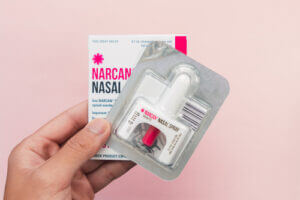How Does Naloxone (Narcan) Work?
Naloxone (Narcan) is an FDA-approved medication that can reverse an opioid overdose.1 For someone who’s overdosed on opioids, the administration of this medication can mean the difference between life and death, as every minute is crucial.
This page will discuss what Narcan is, how it works, and how administering it can potentially save lives.
What Is Narcan?

Narcan, Rivive, and Kloxxado are brand-name formulations of naloxone, a medication that can reverse the life-threatening effects of an opioid overdose. They come in a prefilled device designed for easy, single-dose administration as a nasal spray into the nose.2
Narcan and other forms of naloxone are fast-acting and can quickly restore a person’s breathing in the event of severe, opioid-induced respiratory depression.1
Having naloxone available is recommended for anyone at risk of an opioid overdose, such as those who:2
- Take high-dose prescription opioids.
- Misuse prescription painkillers.
- Use illicit opioid drugs like heroin.
- Use opioids and benzodiazepines together.
Additionally, those with loved ones who use opioids can benefit from carrying and being ready to deliver naloxone, as they may be able to provide emergency assistance if an overdose occurs.
It is recommended for naloxone to be administered after calling 911 anytime an individual is suspected of experiencing an overdose, as this medication causes no harm to someone without opioids in their system.2
If you are uncertain of whether or not someone is experiencing an opioid overdose, there are three key signs to look for, known as the “opioid overdose triad:”3
- Pinpoint pupils.
- Slowed or stopped breathing.
- Loss of consciousness.
Again, if you are unsure if someone is overdosing on opioids, administer naloxone if you can, as doing so will not harm them regardless of what they are overdosing on.2
How Does Narcan Work?
loxone is an opioid antagonist, which means that it works by blocking the effects of opioids. It does this by attaching to opioid receptors and reversing and blocking the effects of opioids. Naloxone reverses slowed or stopped breathing caused by opioids and can restore breathing to its usual state within 2 to 3 minutes.1,2
More than one dose may be required, depending on the potency and amount of the drug(s) taken. Administering naloxone as soon as possible after someone has overdosed is ideal, as the brain can be damaged the longer it is deprived of oxygen.
How Long Does Narcan Stay in the System?
The effects of Narcan or naloxone may only last 30 to 90 minutes. Many opioids, however, stay in the system longer than that. If the dose of Narcan wears off before the opioids do, or if a more potent opioid was taken (e.g., fentanyl), the effects of an overdose can return.1
This is why it is important to stay with an individual who has overdosed until emergency help arrives, so additional naloxone can be administered or other steps can be taken to restore a person’s breathing.2
Overdosing While on Narcan
Overdose is still possible even after taking Narcan. Multiple doses of naloxone are sometimes needed to make sure the person is out of danger of overdosing. People who have taken high doses of opioids or synthetic opioids like fentanyl, in particular, might require multiple naloxone administrations.1,4
If breathing problems continue, Narcan can be given every 2–3 minutes. It is best to monitor the person for at least 2 hours after the last dose of naloxone to ensure that breathing does not stop again.1,4
It is important to note that for those with a physical dependence on opioids, the administration of Narcan or generic naloxone can trigger the rapid onset of withdrawal symptoms. Some symptomatic reactions someone can experience can include the following:1
- Changes in blood pressure.
- Rapid heart rate.
- Nausea.
- Vomiting.
- Tremors.
Despite this possibility, giving naloxone to someone who is overdosing is far more important than attempting to avoid these symptoms, as these symptoms do not cause death like overdose can.1
Where Can I Get Narcan?

Naloxone can be obtained in every U.S. state. Narcan and Rivive are available to purchase over the counter from a local pharmacy without a prescription, while Kloxxado and other generic or brand formulations may require a prescription.
Pharmacies are the most common places to obtain Narcan, but it is also available through public health programs, health departments, and needle distribution programs. Those who are prescribed high opioid doses can benefit by having their doctors prescribe them naloxone.2
Find out where to get Narcan in Mississippi.
Get Help for Opioid Dependence at Oxford Treatment
If you or a loved one is struggling with opioid addiction or misuse, contact our inpatient drug and alcohol rehab in Mississippi right now by calling . We will connect you with one of our compassionate addiction rehab admissions navigators who can answer all of your questions, including those about drug and alcohol rehab insurance coverage, rehab payment options, and the levels of addiction treatment we offer.
Do not wait any longer to reach out for the help you or your loved one needs. Call Oxford today to get more information. You can also get started on your recovery by verifying your insurance and filling out our